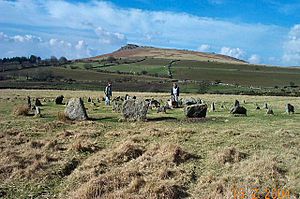Yellowmead stone circle facts for kids
 |
|
| Location | Sheepstor |
|---|---|
| Coordinates | 50°29′35″N 4°00′38″W / 50.492939°N 4.010564°W |
| Type | Stone circle |
| History | |
| Periods | Bronze Age |
| Site notes | |
| Public access | Yes |
The Yellowmead stone circle is an ancient monument located near Sheepstor in Devon, England. It is a special type of stone circle from the Bronze Age. This means it was built a very long time ago, thousands of years before now.
What makes Yellowmead unique is that it has four rings of stones. These rings are set one inside the other, like targets. The biggest ring is about 20 metres wide. The smallest ring is about 6 metres wide. You can find this interesting site on a place called Yellowmead Down.
Contents
What is Yellowmead Stone Circle?
Yellowmead is a concentric stone circle. This means it has circles within circles. Imagine a target with several rings. That's how Yellowmead looks.
The Purpose of the Circles
Long ago, these stone circles likely surrounded a burial mound. This mound is called a cairn. Today, it is very hard to see the cairn. People in the Bronze Age used cairns to bury their dead.
Other Features Nearby
To the southwest of the circles, you can see some possible stone rows. These are lines of stones leading away from the main circle.
There is also an old water channel nearby. This channel is called a leat. It was built after the stone circles. The leat once carried water to a place where people worked with tin. This was part of the old tin mining industry.
Discovering and Restoring Yellowmead
The Yellowmead stone circle has been studied by archaeologists. These are people who learn about the past by digging up old things.
Early Excavations
In 1921, a person named Rev. H Breton worked on the site. He dug up parts of the circle. He also helped to put some of the stones back in place. This is called restoration.
Modern Surveys
More recently, in 2008, scientists used special tools to study the ground. This is called a geophysical survey. They also did a small dig. They wanted to see if the restoration from 1921 was done correctly. It turns out, it was!
They also looked for other hidden features. They found fallen stones that lined up with the stone rows. This suggests there might be more ancient structures buried further down the hill.


